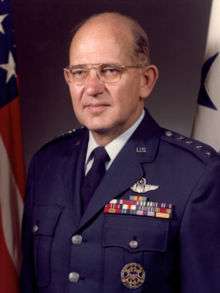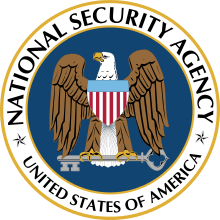Lew Allen
| Lew Allen, Jr. | |
|---|---|
 10th Chief of Staff of the Air Force (1978-1982) | |
| Born |
September 30, 1925 Miami, Florida |
| Died |
January 4, 2010 (aged 84) Potomac Falls, Virginia |
| Place of burial | Arlington National Cemetery, Virginia |
| Allegiance | United States of America |
| Service/branch | United States Air Force |
| Years of service | 1946–1982 |
| Rank | General |
| Commands held |
Air Force Systems Command National Security Agency Chief of Staff, USAF |
| Awards |
Defense Distinguished Service Medal Air Force Distinguished Service Medal Legion of Merit |
| Other work |
Jet Propulsion Laboratory President's Foreign Intelligence Advisory Board |
Lew Allen, Jr. (September 30, 1925 – January 4, 2010) was a United States Air Force four-star General who served as the tenth Chief of Staff of the U.S. Air Force. As the Chief-of-Staff, Allen served as the senior uniformed Air Force officer, who was responsible for the organization, training, and equipping of 750,000 active duty Air Force, Air National Guard, Air Force Reserve, and civilian personal serving in the United States and overseas. As a member of the Joint Chiefs of Staff, he and the other service chiefs function(ed) as the military advisers to the Secretary of Defense, the National Security Council, and the President.
World War II
Born in Miami, Florida, Allen attended and graduated from high school in Gainesville, Texas, in 1942. He entered the United States Military Academy, in 1943, and he graduated in 1946 with a bachelor of science degree and a commission as a second lieutenant. He was awarded his pilot's wings upon his graduation from flight training.[1]
Post-World War II
After completing multi-engine flight training in November 1946, Allen was assigned to Strategic Air Command's 7th Bombardment Group at Carswell Air Force Base, Texas, where he flew B-29 Superfortress bombers, and then the new and very long-range Convair B-36 bomber. Allen also served in various technical positions in the area of nuclear weapons. Allen also attended the Air Tactical Course at Tyndall Air Force Base, Florida, and next he returned to Carswell Air Force Base as a flight instructor and as an assistant Special Weapons Officer for the 7th Bombardment Wing.
In September 1950, Allen entered the University of Illinois for graduate study in nuclear physics. He completed his Master of Science degree in 1952. Allen continued his graduate study, and he earned his Ph.D. in physics in 1954. He had completed an experimental thesis on high-energy photonuclear reactions. General Allen then was assigned to the U.S. Atomic Energy Commission's Los Alamos Scientific Laboratory in Los Alamos, New Mexico, as a physicist in the Test Division, where he became acquainted with the bomb designer Ted Taylor. Allen conducted experiments in several different nuclear test series. These experiments concerned the physics of thermonuclear weapons design and to the effects of high altitude nuclear explosions conceivably to be used for ballistic missile defense.
From June 1957 to December 1961, Allen was assigned to Kirtland Air Force Base, New Mexico, as the science adviser to the Physics Division of the Air Force Special Weapons Center. ("Special weapons" is a euphemism for nuclear and thermonuclear bombs.) Allen specialized in the military effects of high altitude nuclear explosions and participated in several nuclear weapons test series. He was scientific director of a major experiment that utilized a large series of high altitude rockets to measure the characteristics of electrons trapped in the geomagnetic field after an exoatmospheric nuclear burst.
Allen was assigned in December 1961 to the Office of the Secretary of Defense, Space Technology Office, in the Directorate of Research and Engineering, Washington, D.C. From June 1965 to February 1973, he was assigned to the Office of the Secretary of the Air Force, initially in Los Angeles, California, as the Deputy Director for Advanced Plans in the Directorate of Special Projects. Allen next moved to The Pentagon in June 1968 as the Deputy Director of Space Systems, and in June 1969, he became the Director. He returned to Los Angeles in September 1970 as the assistant to the Director of Special Projects and in April 1971 became the Director of Special Projects, with additional duty as the Deputy Commander for Satellite Programs of the Space and Missile Systems Organization.
After serving briefly as the Chief-of-Staff for the Air Force Systems Command at Andrews Air Force Base, Maryland, Allen was appointed in March 1973 as a deputy to the Director of Central Intelligence for the Intelligence Community in Washington, D.C. In August 1973, Allen became the Director of the National Security Agency (N.S.A.) and the Chief of the Central Security Service at Fort George G. Meade, Maryland. Allen's tenure as the N.S.A. director was noteworthy in that he became the first N.S.A. director to ever testify publicly before Congress.[2] In August 1977, he was named Commander of Air Force Systems Command.
Allen served as the Vice-Chief-of-Staff of the U.S. Air Force from April 1978 until he became the Chief of Staff of the Air Force in July 1978. His nomination was unusual in that he had never served in an overseas or combat assignment, and most of his positions were in specialized technical activities, rather than in the usual command structure of the Air Force. Also, he was the last chief of staff with a bomber background; all subsequent Chiefs of Staff except General Norton Schwartz have been fighterplane pilots, and this trend is reflected by the Service's weapon budgets, which devote most funding to fighterplanes rather than bombers.
Following his retirement from the Air Force in 1982, Allen became the Director of the Jet Propulsion Laboratory (J.P.L.), during part of the Voyager Program (space probes launched in 1977), and he served as the Director of the J.P.L. until 1990.
General Allen was a member of the National Academy of Engineering[3] and the Council on Foreign Relations.
From 1993 to 1995, Allen served as a member of the President's Foreign Intelligence Advisory Board (PFIAB) and the Intelligence Oversight Board.[4]
Allen was awarded the 1999 Distinguished Graduate Award of the Association of Graduates, the alumni association of West Point graduates.[4]
Allen died in Potomac Falls, Virginia, on January 4, 2010 of complications from rheumatoid arthritis.[5] He was buried at Arlington National Cemetery on March 22, 2010.[6]
Legacy
The U.S. Air Force has created an award in Allen's honor, the General Lew Allen, Jr., Trophy, which is awarded annually to an Officer and a Senior NCO in the aircraft maintenance or munitions career fields directly involved with setting up aircraft sorties.[7]
Since 1986, the Jet Propulsion Laboratory awards in his honor the Lew Allen Award for Excellence, until 1990 called the Director’s Research Achievement Award.[8]
Awards and decorations
| Command Air Force Pilot Badge | |
| Master Missile Badge | |
 |
Joint Chiefs of Staff Badge |
|
Defense Distinguished Service Medal with bronze oak leaf cluster |
| Air Force Distinguished Service Medal | |
|
Legion of Merit with two bronze oak leaf clusters |
| Joint Service Commendation Medal | |
| Air Force Outstanding Unit Award | |
| Air Force Organizational Excellence Award | |
| National Intelligence Distinguished Service Medal | |
| American Campaign Medal | |
| World War II Victory Medal | |
|
National Defense Service Medal with bronze service star |
|
Air Force Longevity Service Award with silver and two bronze oak leaf clusters |
| Order of National Security Merit, Gugseon Medal | |
| Unknown ribbon | |
References
- ↑ "General Lew Allen Jr.". Official Website of the US Air Force. Retrieved 2014-06-25.
- ↑ Bamford, James (1983). The Puzzle Palace. New York: Houghton Mifflin Company. pp. 111–112. ISBN 0-14-006748-5.
- ↑ "Dr. Lew Allen Jr.". National Academy of Engineering. Archived from the original on 2006-06-15. Retrieved 2006-07-16.
- 1 2 "Association of Graduates, USMA". 1999 Distinguished Graduate Award. 1999. Retrieved 2006-04-15.
- ↑ Martin, Douglas (January 9, 2010). "Gen. Lew Allen, Who Lifted Veil on Security Agency, Is Dead at 84". The New York Times.
- ↑ http://archive.is/20120720071804/http://www.af.mil/news/story.asp?id=123196350
- ↑ "AFI 36-2603" (PDF). The USAF Maintenance Awards Program. USAF. Retrieved 2008-01-23.
- ↑ "Science and Technology: The Lew Allen Award for Excellence Recipients". JPL. Retrieved 12 May 2015.
![]() This article incorporates public domain material from the United States Air Force document "General Lew Allen Jr.".
This article incorporates public domain material from the United States Air Force document "General Lew Allen Jr.".
External links
- Official Air Force biography
- JPL mourns passing of former director Lew Allen – JPL/NASA News Service
| Government offices | ||
|---|---|---|
| Preceded by Samuel C. Phillips |
Director of the National Security Agency 1973–1977 |
Succeeded by Bobby Ray Inman |
| Military offices | ||
| Preceded by Gen. David C. Jones |
Chief of Staff of the United States Air Force 1978–1982 |
Succeeded by Gen. Charles A. Gabriel |
| ||||||||
| ||||||||||
|

